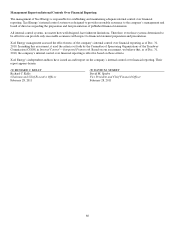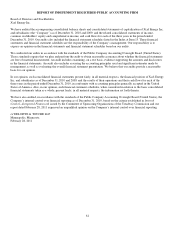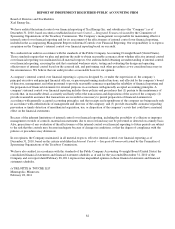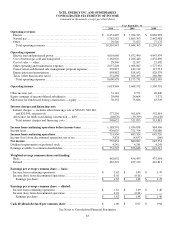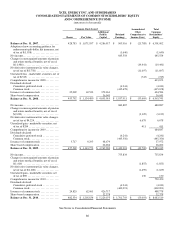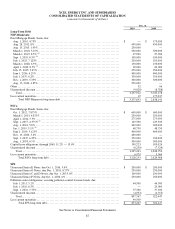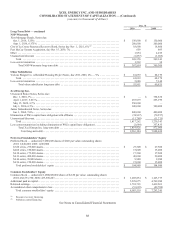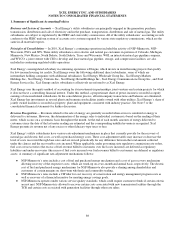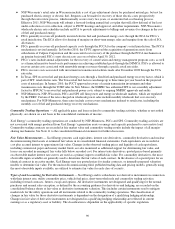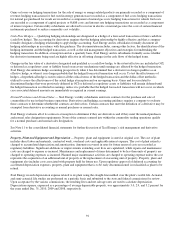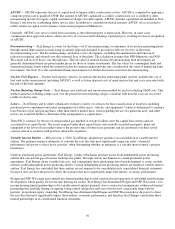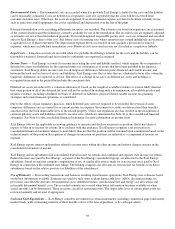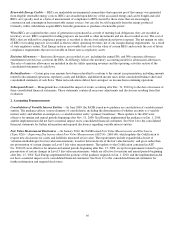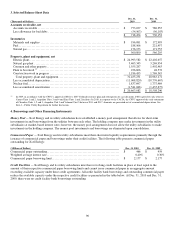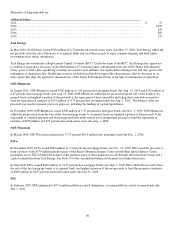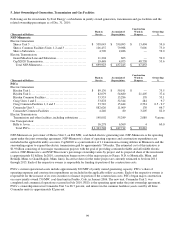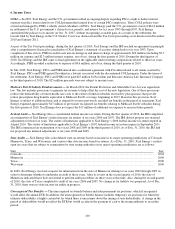Xcel Energy 2010 Annual Report Download - page 100
Download and view the complete annual report
Please find page 100 of the 2010 Xcel Energy annual report below. You can navigate through the pages in the report by either clicking on the pages listed below, or by using the keyword search tool below to find specific information within the annual report.90
● NSP-Wisconsin’s retail rates in Wisconsin include a cost of gas adjustment clause for purchased natural gas, but not for
purchased electric energy or electric fuel. Requests can be made for recovery of those electric costs prospectively
through the rate review process, which normally occurs every two years, or an interim fuel-cost hearing process.
Effective 2011, NSP-Wisconsin will submit a forward-looking annual fuel cost plan that will allow deferral of fuel cost
under-collection or over-collection, subject to PSCW hearings and approval, and other requirements. NSP-Wisconsin’s
wholesale electric rate schedules include an FCA to provide adjustments to billings and revenues for changes in the cost
of fuel and purchased energy.
● PSCo generally recovers all prudently incurred electric fuel and purchased energy costs through the ECA for PSCo’s
retail jurisdiction. The ECA allows for sharing of margins on short-term energy sales and margins from the sale of SO2
allowances.
● PSCo generally recovers all purchased capacity costs through the PCCA for the company’s retail jurisdiction. The PCCA
mechanism is revised annually. In October 2010, the CPUC approved the acquisition of generation assets from
subsidiaries of Calpine Corporation and the associated cost recovery of the purchase through the PCCA mechanism on
an interim basis until PSCo’s next electric rate case on or before April 30, 2012.
● PSCo’s rates include annual adjustments for the recovery of conservation and energy management program costs, as well
as a financial incentive based on its performance in achieving established goals through the DSMCA. PSCo is allowed to
recover certain costs associated with renewable energy resources through a specific retail rate rider.
● PSCo recovers costs associated with investment in transmission facilities made after December 2008 through the TCA
rate rider.
● In Texas, SPS recovers fuel and purchased energy costs through a fixed fuel and purchased energy recovery factor, which is
part of SPS’ retail electric rates. The Texas retail fuel factors can change up to three times per year based on the projected
costs of natural gas. In January 2010, the PUCT approved recovery of certain transmission investments and other
transmission costs through the TCRF rider. In New Mexico, the NMPRC has authorized SPS to use a monthly adjustment
factor for FPPCAC to recover fuel and purchased power costs, subject to ongoing NMPRC approvals and audits.
● NSP-Minnesota, NSP-Wisconsin, PSCo and SPS sell firm power and energy in wholesale markets, which are regulated
by the FERC. Certain of the rates charged on wholesale power sales include monthly wholesale fuel cost-recovery
mechanisms. For NSP-Minnesota, these rates include cost recovery mechanisms indexed to retail rates, including the
monthly cost of fuel and purchased energy recovery mechanisms.
Commodity Trading Operations — All applicable gains and losses related to commodity trading activities, whether or not settled
physically, are shown on a net basis in the consolidated statements of income.
Xcel Energy’s commodity trading operations are conducted by NSP-Minnesota, PSCo and SPS. Commodity trading activities are
not associated with energy produced from Xcel Energy’s generation assets or energy and capacity purchased to serve native load.
Commodity trading contracts are recorded at fair market value and commodity trading results include the impact of all margin-
sharing mechanisms. See Note 11 to the consolidated financial statements for further discussion.
Fair Value Measurements — Xcel Energy presents cash equivalents, interest rate derivatives, commodity derivatives and nuclear
decommissioning fund assets at estimated fair values in its consolidated financial statements. Cash equivalents are recorded at
cost plus accrued interest to approximate fair value. Changes in the observed trading prices and liquidity of cash equivalents,
including commercial paper and money market funds, are also monitored as additional support for determining fair value, and
losses are recorded in earnings if fair value falls below recorded cost. For interest rate derivatives, quoted prices based primarily
on observable market interest rate curves are used as a primary input to establish fair value. For commodity derivatives, the most
observable inputs available are generally used to determine the fair value of each contract. In the absence of a quoted price for an
identical contract in an active market, Xcel Energy may use quoted prices for similar contracts, or internally prepared valuation
models to determine fair value. For the nuclear decommissioning fund, published trading data and pricing models, generally using
the most observable inputs available, are utilized to estimate fair value for each class of security.
Types of and Accounting for Derivative Instruments — Xcel Energy and its subsidiaries use derivative instruments in connection
with their interest rate, utility commodity price, vehicle fuel price, short-term wholesale and commodity trading activities,
including forward contracts, futures, swaps and options. All derivative instruments not designated and qualifying for the normal
purchases and normal sales exception, as defined by the accounting guidance for derivatives and hedging, are recorded on the
consolidated balance sheets at fair value as derivative instruments valuation. This includes certain instruments used to mitigate
market risk for the utility operations and all instruments related to the commodity trading operations. The classification of
changes in fair value for those derivative instruments is dependent on the designation of a qualifying hedging relationship.
Changes in fair value of derivative instruments not designated in a qualifying hedging relationship are reflected in current
earnings or as a regulatory asset or liability. The classification is dependent on the applicability of specific regulation.


